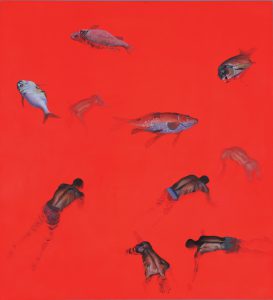Esteban Catalog Entry

Johnson unapologetically exposes the catastrophic placelessness of the queer black male body in his 2012 piece, Lost at Sea, ii, with imagery that transports the viewer to other spaces and times. While the sight of floating black bodies and dead fish bobbing about a sea of red are visually macabre, these images are poignant and purposeful, even poetic. Through his representation of the black male body and interest in the queer experience in the Caribbean, Johnson becomes political through his work—looking for justice, or even redemption, for the black male after centuries of oppression, subjugation, and death. By layering tragic historical narratives, Johnson offers a critique of the past to make a claim about the present: though the status of black men has changed over time from enslaved to free, oppression and violence have endured, making certain identities, such as the queer identity, impossible within a Caribbean context. These impossible subjects remain to be lost at sea.
Johnson’s multifaceted piece makes overt connections to the past. The floating black bodies provide somber reminders of the horrors of the Middle Passage, as slaves, dead or alive, were thrown overboard to a watery grave—a disposal that epitomizes the lack of humanity inflicted upon black subjects. These subjects are sentenced to an existence lost in this abyss. Édouard Glissant’s essay, “The Open Boat,” explores this subjugation of the black body to an abysmal space:
“This boat is your womb, a matrix, and yet it expels you. This boat: pregnant with as many dead as living under sentence of death. The next abyss was the depths of the sea. Whenever a fleet of ships have chase to slave ships, it was easiest just to lighten the boat by throwing cargo overboard, weighing it down with balls and chains.” (p. 6)

For these slave ships, cargo was defined as the enslaved people who filled the ships’ bellies. These people are thereby commoditized—things, not people, were ejected. Johnson’s piece echoes these practices, where the floating black bodies amongst the dead fish can be interpreted as the dismal fate of the enslaved. They are those bodies left behind on the way to the New World, forever left to swim with the fishes. However, these bodies were not weighed down by balls and chains, but rather left to float on the surface as a reminder of violence behind these catastrophes. Johnson builds upon this narrative and moves beyond a colonial context to make more contemporary associations.
There are modern connections that can be made as well, particularly in regards to the AIDS epidemic in the Caribbean during the 1980’s. This, like slavery, was a death sentence that targeted black men, particularly those who identified as LGBT. Johnson’s use of red can be symbolic of blood, not only blood that was shed during colonial times, but also the blood through which disease was transmitted via queer sexual encounters. The floating men can be understood as men who succumbed to the disease—their death is a consequence of their queerness. Johnson’s figures aren’t anchored, but rather freely float about, underlying the placelessness and precariousness experienced by queer subjects in the Caribbean.
The queer identity of Johnson’s subjects is reinforced by the fish that surround them, connecting to both the Dancehall culture and homophobic climate of Jamaica. In slang terms, “fish” is used as a homophobic slur to refer to a homosexual man. It is often employed by Dancehall artists as a technique to diss one another, thereby challenging each other’s masculinity and sexuality by claiming the other man is a homosexual. For example, in Mavado’s diss track about fellow Dancehall artist Popcaan, “Dem Dead A’Ready,” he sings:
“One line ’bout, “dutty dread”
Fish bwoy, with the bubbles inna fucking head
Rock off, and pop off, all yuh puppy dead
Step over dem yard and kill, all who nuh fi dead” (Mavado)
Here, Mavado is not only calling Popcaan a fish boy in an attempt to insult him by challenging his sexuality, but also insinuates that fish boys should be killed. In doing so, these male artists battle at the expense of the queer community. This underlines the hypermasculinity and heteronormativity of Jamaican culture. Accordingly, the fish Johnson places next to the black bodies confirms the identity of these bodies as queer. The fish, like the bodies, are also dead, conflating the two identities—the men become fish and the fish become men. These are “fish” men. They are undeniably queer.
In this way, Johnson exposes the vulnerability of these men by highlighting their lack of autonomy over their identity. They can be exposed at any time and can be the subjects of extreme violence once they are found out. These are the fears faced by the characters in Powell’s novel, A Small Gathering of Bones, where Dale actively tries to conceal his queer identity by allocating it to the private sphere, yet overtly engages in homosexual acts within public spaces. This theme is paralleled in Johnson’s piece, where the public and private merge—the private lives of these male bodies are exposed for all to see. Therefore, Johnson’s work complicates the typical narrative of Caribbean queerness by connecting to vital historical experiences in order to comment on the Gully Queens of the present. Unfortunately, many of these impossible subjects remain lost at sea, without a place in the real world. But within art like Johnson’s, they find a place where they can begin to reconcile their stories.
Works Cited
Glissant, Édouard. “The Open Boat.” Poetics of Relations translated by Betsy Wing. The University of Michigan Press, 1997.
Mavado. Lyrics to “Dem Dead A’Ready.” Genius, 2016, https://genius.com/Mavado-dem-dead-aready-lyrics.